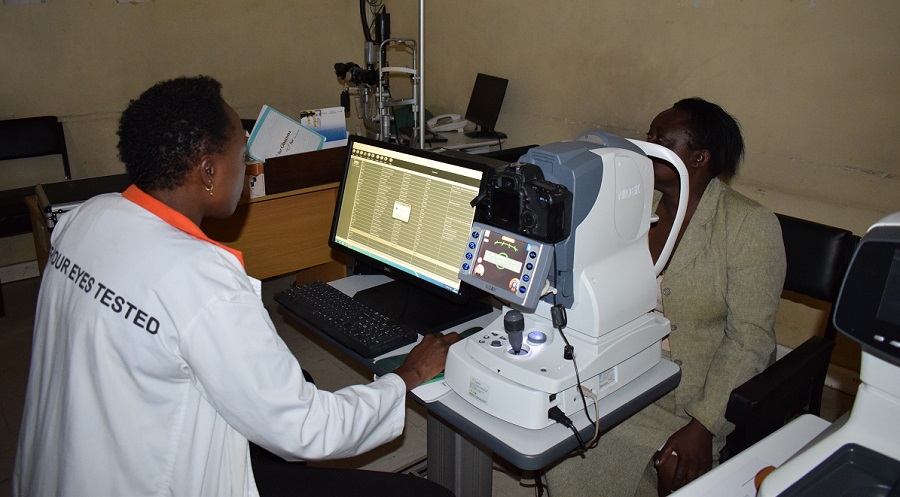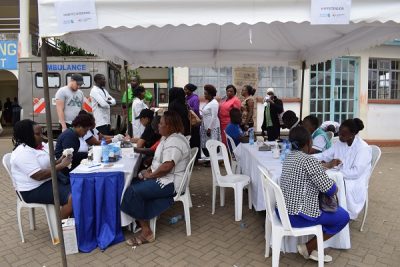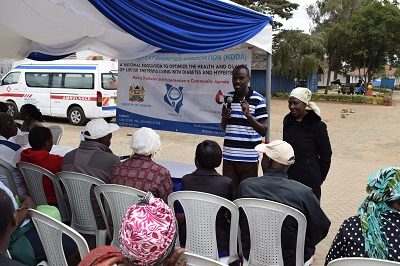Join a powerful, unprecedented alliance for better eye health for all.
Join IAPB-
Choose an alternate language here

In 2017, Seeing is Believing, supported The Fred Hollows Foundation Kenya to implement a two-year Diabetic Retinopathy Project in Nairobi and the surrounding areas. This project is coming to an end in December 2019 after going through a learning phase. Diabetic Retinopathy has gained significance in the back-drop of an ever increasing burden due to Non-communicable diseases (NCDs) in Kenya. Health facilities in the capital city are increasingly registering cases of Type 2 diabetes which has necessitated the incorporation and integration of screening for DR at the diabetes clinics. The main aim of this project, therefore, was to promote the integration of DR management into routine diabetes disease management and screen all patients for DR alongside other diabetes disease management procedures.

The Fred Hollows Foundation Kenya partnered with Department of Health of The Nairobi City County Government through the Mbagathi Hospital and the Ministry of Health to provide this initiative which also doubled up as a learning experience as DR management is still new to the County Government.
Through partnership with the vitreo-retinal surgeons from the University of Nairobi and Kenyatta National Hospital, the project trained clinicians from both the Mbagathi Hospital Eye Unit and the Diabetes Out-patient Clinic. This was followed by training of twenty six clinicians drawn from various sub-county facilities in Nairobi who were principally trained on screening and referral of patients with DR. The project was intended to prepare the County to provide access to DR management in the county health facilities and through an integrated and sustainable approach.
During the inception period, capacity building and identification of strategic partners dominated the space. Fundus cameras were purchased and installed at the diabetes clinic. Team approach was enhanced with inclusion of eye unit team, the diabetes clinic team and the health records information office. The project quickly learned that success would not be found if the community angle was not included. This ushered in the Kenya Defeat Diabetes Association, a group comprising of people with diabetes. It is this fourth angle that proved to be the driver for sustainability. There was a slow start as patients were not sure what diabetes had to do with their eyes and this dramatically changed with the advent of the KDDA team supporting peer to peer education at the community and clinic level. To date awareness has reached a high level as patients demand fundoscopy during routine clinic days.
Supply of diabetic drugs has remained a challenge and the very dear at commercial chemists in town. KDDA peer educator groups have taken the initiative of sourcing for quality diabetic drugs at cheaper rates with the support of the Department of Health and dispensing to their members at affordable rates. This has led to a decrease in defaulter rates and increase in adherence to medication. Supervision of this aspect is provided by the clinical team who oversee the dosages and ensures that there is no abuse of the concept.
There is effective collaboration between the peer educators and the clinicians who often rely on the support of the peer educators for patient mobilization, education and post-screening counselling.
By March 2019, the project had two functional hand-held fundus cameras and one static fundus camera. The referral pathway has already been established and the national DR guidelines being used in the management of DR at all the facilities.

Diabetic clients are beginning to appreciate the need to have their eyes checked and are showing great commitment to return for further checks as advised by the clinicians. The motivation of patients to join the peer groups is worth noting as they get access to inexpensive treatment as medicines are provided through the Peer Educator Groups. The mark-up they get from dispensing these medicines is used for transport and related costs as they crisscross the city in a bid to locate and educate more people regarding diabetes eye disease and positively impact on the eye health seeking behavior amongst people with diabetes.
The seed sown by the 26 clinicians from Mbagathi and the 18 peer educators from the community is bearing fruit as they continue to train clinicians from other health facilities across the city thus ensuring that as many diabetic patients undergo fundoscopy and this has a ripple effect in increasing the number of patients joining the Association and benefiting from the services given under the KDDA umbrella. The increased number of clinical staff with knowledge on DR will ensure that more patients get screened beyond the project life as the skills are honed and remain in the county. Continuum of care is already being established with patients who need further treatment being provided with a clear referral path, where need arises.
Throughout the project cycle, the project has continuously advocated to the policy makers and the Nairobi City County Government to take up responsibility of the project activities. This they have done through the NCD department and is currently promoted under diabetes management. The county government has also adopted the use of the national guidelines with which they provide support supervision in the project. This gesture clearly shows the willingness by action of the county government in ensuring that the gains made in this project is sustained beyond its donor-funding.
For such complex projects, it is vital that proper partner mapping is conducted and the roles clearly defined under an operational framework. This helps in defining the scope of the project and the capacities that need to be developed. This project has clearly shown that collaboration between the different players and the inherent skills and capacities of each can lead to gains beyond the available resources. This project is utilizing the small level of funding to reach out to more and develop paths for sustained outcomes.
Herbert Dola,
The Fred Hollows Foundation,
Kenya